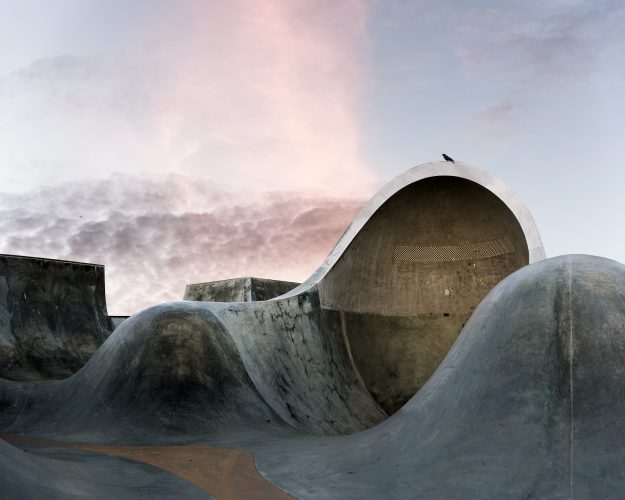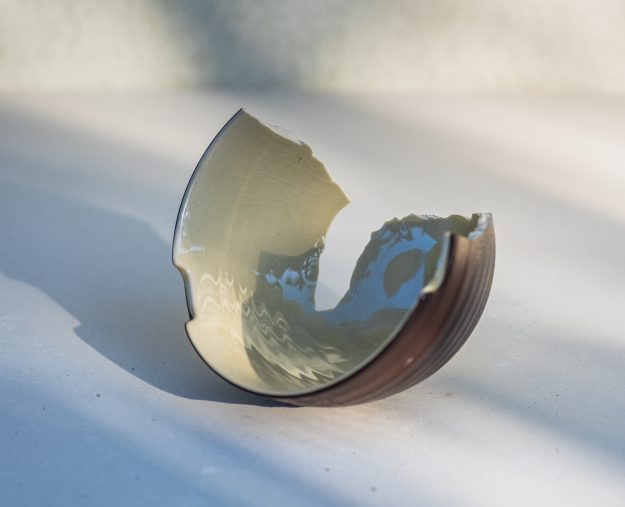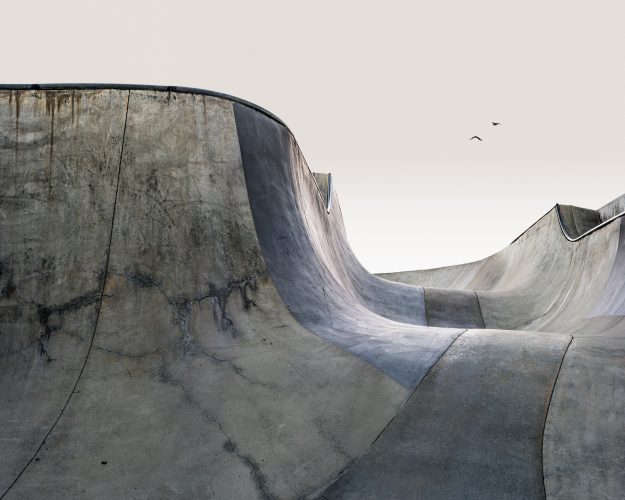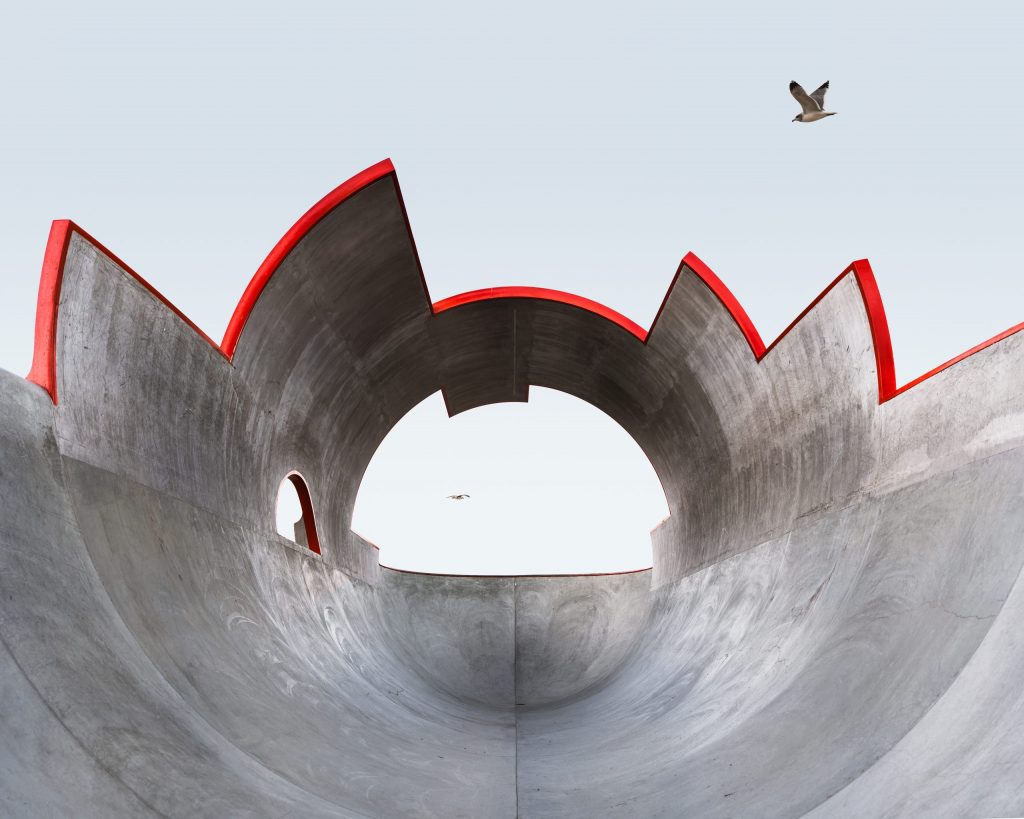Born in 1974, American photographer, video artist, and UC, Riverside, art professor Amir Zaki was raised in the rural city of Beaumont, California. Nestled between undeveloped farmland and cherry orchards, with San Gorgonio Mountain and Mount San Jacinto piercing the northern and southern horizons, the mountain town rode the waves of the skateboarding explosion that would hit California’s southern coast during the late 1970s. As a child growing up in that era, Zaki would start skateboarding as an adolescent, and his experiences as a skateboarder as well as his many years later spent studying Zen Buddhist philosophy would go on to influence some of his most contemplative and reflective pieces, highlighting many of California’s natural and built landscapes.
In California Concrete: A Landscape of Skateparks (2019), Zaki captivatingly depicts vacant California skate parks, which he describes as “essentially large and elaborately designed empty vessels, as much as they are concrete models of naturally found features of the landscape and seascape, such as mountains, hills, rocks, and waves.” The juxtaposition of barreling waves with the coping-lined lips of bare concrete inclines, which are “born out of conceptions of various curvilinear shapes found in nature,” recall the serene emptiness found in many Zen gardens and their own interpretive representations of more natural settings. For Zaki, there is a direct through line between his evolving philosophical inquiry as well as his artistic practice. As he recently shared, “the act of photographing has a lot in common with sitting zazen.” It’s not so much the particular locations that he finds meditative—though his chosen settings are often quiet and peaceful—rather, it’s in the act of careful and considerate observation of the world around him. Through his work, Zaki aims to showcase how the concept of “emptiness” can be found in everyday scenes and familiar landscapes and to disrupt apparent dualities so that viewers can perhaps see the world anew.

Tricycle contributor Seth M. Walker recently spoke with Zaki in depth about his work and the sensibilities guiding it, as well as the photographs of broken ceramics that accompany the skate parks of his “Empty Vessel” series.
This interview has been edited for length and clarity.
Can you tell us a little bit about your background as a photographer? I got fiercely curious about photography when I was in college. There was an instantaneous connection for me between the mechanical nature of the medium (the camera), the philosophical way you could approach things using a visual language, and the freedom to explore my world this way.
For more than a decade, I used a process that, for short, we refer to as “Gigapan” photography. Gigapan is the brand name of a robotic tripod head that moves in a precise manner, allowing the user to mount a digital camera on it and photograph a scene with dozens of overlapping photographs, like a mosaic. In postproduction, you use software to “stitch” together the photographs seamlessly. This way of working has conceptual/philosophical implications that destabilize certain qualities that most people think of as a necessary and sufficient condition for photography. A photograph is made over the span of ten to fifteen minutes, while the light changes, the sun moves in and out of cloud cover, shadows appear and disappear, and birds and planes come and go in the sky. These images are seamed together to form a photograph that can and often does appear to capture one “moment.” But, in many of my photographs, I capitalize on the inconsistencies, the subtle changes that take place over time, and instead of a single “moment,” I hope to complicate our idea of what a photograph can be but also to expand our notion of what the “present” can be.
I photograph landscapes and architecture. In short, I focus my attention on built subjects and those that become over time (grow, evolve, change). Using the Gigapan process has allowed me to playfully undercut some of our culturally ingrained notions about what a photograph is and to explore more expansive ideas about time and space, and ultimately how we define the natural.
This sounds like a fairly niche method of shooting. Was your introduction to Gigapan by chance, or was it more directly connected to some of the sentiments underlying your initial interest in photography? When Gigapan technology came out, it was kind of gimmicky and intended for people to shoot large scenes that they could upload to the internet, and [so that] users could zoom in from really far away and the image would maintain its resolution. Artists like myself recognized its potential for making very high resolution images for printing and exhibition purposes, rivaling and surpassing the quality of large format analog photography. Then, as we experimented with it, refining the technique, we realized some of the conceptual potential that Gigapan photography afforded us ([as well as the] limitations it created), especially when depicting time and space, which was really exciting.
Varying tensions seem to underlie much of your work—between the functional/dysfunctional; here/there; subject/object; natural/built; landscape/architecture; inside/outside; empty/full. How do these tensions contribute to the photographs you take? Part of my personality, for better or worse, compels me to consider ideas from multiple perspectives. Photography lends itself to many apparent dualities, such as positive/negative, light/dark, and absence/presence. It has long made sense to me to extend these technical medium-specific ideas into the conceptual ideas in my work. You bring up several of those in your question. Is it a tension, though? Perhaps the interplay between and within these apparent dualities is more of a way for me to expose the relative quality of these dualities and that they are ultimately “empty.”
The duality between empty and full is especially important for your “Empty Vessel” series and in the additional photographs of vacant skate parks that appear in California Concrete. Can you tell us about these two projects—how they were conceived, how they overlap and intersect, how broken ceramics and expansive skate parks similarly engage with emptiness and fullness? In my early 30s, I had a short renaissance with skating when my body could still handle the physical consequences of falling, and I fell in love with the designs of the concrete parks. By showing up at dawn and getting creative in my approach to access, I discovered that I could photograph empty skate parks from within, focusing all my attention on their forms as they relate to and mimic the natural landscape, as well as how they relate to architecture (are they even architecture?). As I was looking at working prints of these skate parks, I asked myself a very deceivingly simple question, “What are these spaces?” My answer was that they were empty vessels. They are often excavations of the land (like a swimming pool) and filled with concrete. They contain pure potential, as they are meant to hold something, namely a skateboarder, like a cup or a bowl, which is meant to hold liquid. I loved that idea. This also led me to acquire, break, and photograph ceramics.

You close California Concrete with a passage from the Tao Te Ching , which specifically focuses on the importance and meaning of emptiness. That philosophical preoccupation with emptiness (sunyata) isn’t foreign to Buddhist philosophy either. I understand you have a background and interest in Eastern philosophy—Zen, in particular. Can you tell us a bit about that and how it influences your work? I have a long interest in Eastern and Western philosophy. Aside from reading, I have a decades-long informal but ongoing sitting and koan practice. It just so happens that my best friend from childhood, Tom Chigen Bartholomew, received his Dharma Transmission from Tenshin Fletcher Roshi at Yokoji Zen Mountain Center. Chigen—who leads Citrus Zen in Redlands, California—and I are the closest thing to brothers without actually sharing DNA. We have had countless conversations about Zen over twenty years. That said, I’m not a very dogmatic person, so I’ve never taken precepts or done anything formal other than a few short retreats. But I’ve lived most of my adult life with a strong leaning toward a Zen Buddhist perspective. It’s hard to separate the way Zen influences my work from the way it influences my life because it just is my life.
The act of photographing has a lot in common with sitting zazen.
Approaching photography as a way to destabilize and complicate ingrained notions of what a present moment is sounds very Buddhist too. Do you notice an obvious overlap between your koan practice and your perspective as a photographer? Are there any particular koans or collections that remain particularly impactful in this regard? While photographing, I often ask myself things like, “What is this?” And, most of the time, while I’m photographing, I’m really just photographing. I’m having a direct experiential moment with what I’m observing, the particular light, the camera settings, my body’s aches and pains depending on how I’m positioned, etc. I mean, that is the essence of koan practice: direct experience. The first koan I was exposed to was, “Stop the sound of a distant temple bell.” I worked on this, and gave up on it, for perhaps five or six years before passing. Since then, looking through my notes, I’ve probably worked on fifty more or so. The first koan is the most memorable in the way it humbled me for so long, exhausted me mentally, embarrassed me, made me feel dumb, made koans seem stupid, and finally I ran out of places and patterns for my thoughts to run and hide. That was a beautiful afternoon. I was picking my kids up from elementary school and texting back and forth with Tom until he called me and said, “Yes!”
That certainly sounds like a memorable moment—and one aligned with the transformative journeys koans often lead to. Are there any particular Zen teachings or teachers you find to be most influential? The first time I read the Sandokai (Shitou Xiqian), it was out loud with the sangha at Yokoji, and I couldn’t make it through. I can still feel my throat closing up and my eyes filling with tears. Those last lines really get me, “When you walk the Way, it is not near, it is not far. If you are deluded, you are mountains and rivers away from it. I respectfully say to those who wish to be enlightened: Do not waste your time by night or day.” In September 2023, after a grand mal seizure, I was diagnosed with an inoperable brain tumor that there is no cure for, and [that] I must manage for the rest of my life. While in the hospital, my brother brought me a small copy of The Hsin-Hsin Ming, Verses of the Faith-Mind by Seng-ts’an, the third Chan (Zen) patriarch. I keep this in my laptop bag and take it wherever I go. It ends with, “Words! Words! The Way is beyond language, for in it there is no yesterday, no tomorrow, no today.”

What I find especially intriguing is that although the skate parks in your photographs are missing skaters, there is a noticeable sense of presence amid absence, just as the ceramic shards signal their otherwise complete forms. In Zen traditions, broken bowls are often used as symbols of impermanence. There’s also the Japanese art of kintsugi, where the brokenness of bowls is highlighted rather than hidden as they’re pieced together. Would you say your style of shooting and composition could be seen as an extension of kintsugi? Or the antithesis? Are the shots you edit together highlighting flaws or hiding them? Kintsugi often comes up when discussing the broken vessels I made and photographed. Of course, I am quite familiar with the art form. By nature, or by upbringing, or both, I am somewhat irreverent, especially when it comes to tradition. That’s how I feel about kintsugi. Yes, it recognizes the flaws as beauty, but ultimately, it’s just too precious for me. Why not just leave it busted? To me, that seems to embrace wabi-sabi more than painstakingly gluing a bowl back together and highlighting the cracks. Another incredibly important distinction needs to be made. Kintsugi is an art form where the art object is a vessel. My artworks are photographs. They are images. The light, shadow, focus, blur, and composition of the broken vessel within the context of a flat print is the work, transformed. The broken ceramic object is not the work and may as well not exist.
Some of my favorite photographs in California Concrete are the ones you took at the skate park in Rancho Santa Margarita. The collection’s opening shot reminds me of cascading water flowing gently between towering cliffs and sun-streaked ledges. The elevated crater-like bowl a few pages later is bursting with a volcanic sort of energy amid its recessed, hollowed form. What do you see in these types of photographs? And how do they capture your vision for this project and the correlating non-skate-park subjects in “Empty Vessel”? As a photographer who has invested so much time in the built and natural landscape, I see many of the skate parks mimicking forms found in the natural landscape. I see Half Dome at Yosemite [in them]; I see Zion National Park. I also see the subtle, quickly changing colors of morning light and how they reflect beautifully off the different kinds of concrete surfaces. But, as a skateboarder, I also “see” the potential lines that I may desire to ride as a goofy footer. The juxtaposition of the skate parks with the broken vessels in the exhibition “Empty Vessel” is meant to prompt the viewer to consider the relationships, both formal and conceptual, between the two very different subjects.

How do the cracks in the hard concrete interrelate with the sharp, broken, and fragile edge of a ceramic bowl? How does our mind “fill in” the missing pieces of a broken vessel, and is that much different from filling in the missing skateboarder flying through the air or catching some tile? And, of course, how is “emptiness,” in a Buddhist sense, to be considered in both types of pictures? I hope the two kinds of photographs viewed together point (like a finger at the moon) to the “not two-ness” of our world.
Thank you for subscribing to Tricycle! As a nonprofit, we depend on readers like you to keep Buddhist teachings and practices widely available.
